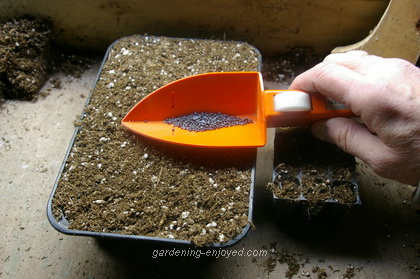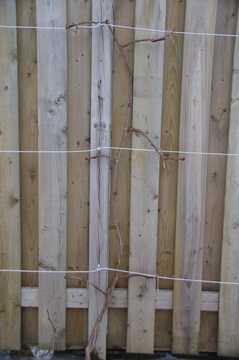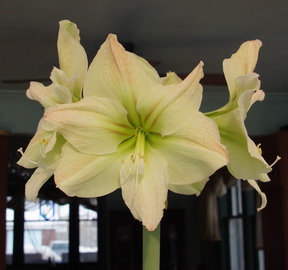| Back to Back Issues Page |
 |
|
Dallying In The Dirt, Issue #158 --- February is almost gone it's time to be seeding onions. February 22, 2014 |

Here it is the last week of February and the mail box was filled with seed packets, most particularly my several varieities of Onion seeds. I visited William Dam seeds last fall and liked this small family company, so I checked out their site early in the week, looking for Onion seeds. They had a great selection so I ordered a few. An email from them noted the order and said it would be out in 2-3 weeks unless I needed a rush. Replied that I needed the Onion seeds to plant asap and the seeds showed up 2 days later. Great service. Now it’s time to get down in the basement and actually plant those seeds. Onions can go in the ground outside as early as possible and they need a few weeks to get from seed to transplant, so it’s this week to fire up the germination area. I have tried Onions broadcast in a large seeding tray and for a couple of years tried them individually
sown in plug trays. Plug trays are a lot more work and take up much more space and the end result was not noticeably better. It’s back to broadcast seed trays this year. The secret is too not sow them too thickly, get them nicely covered but not buried and soak the soil well. We should have little green shoots by the end of the week.  It was actually warming up this past week and we also had a day with significant rainfall. I managed to get in my usual day of skiing without the extra extra sweater and it was wonderful. I left a bit early as the rain was beginning and I had no desire to put on my green garbage bag. All of that weather has managed to reduce the amount of snow in the backyard to the point where I will be able to wander out there. There is one large Grape vine that needs to be pruned and a sunny day in late winter is the perfect time to do it. I ripped out one of the Grape vines last fall. I managed to produce a great harvest but simply didn’t like the fruit. I will follow some fairly careful rules to prune the other vine. Almost 90% of the vine is cut off and you are sure that you have killed it but it comes roaring back in the spring with massive amounts of growth. I follow what is called, a kniffen system, that
leaves me with six fruiting branches that get trained along horizontal wires. The other result is enough vine laying on the snow to make more grape vine wreaths than I could ever find a use for.
It was actually warming up this past week and we also had a day with significant rainfall. I managed to get in my usual day of skiing without the extra extra sweater and it was wonderful. I left a bit early as the rain was beginning and I had no desire to put on my green garbage bag. All of that weather has managed to reduce the amount of snow in the backyard to the point where I will be able to wander out there. There is one large Grape vine that needs to be pruned and a sunny day in late winter is the perfect time to do it. I ripped out one of the Grape vines last fall. I managed to produce a great harvest but simply didn’t like the fruit. I will follow some fairly careful rules to prune the other vine. Almost 90% of the vine is cut off and you are sure that you have killed it but it comes roaring back in the spring with massive amounts of growth. I follow what is called, a kniffen system, that
leaves me with six fruiting branches that get trained along horizontal wires. The other result is enough vine laying on the snow to make more grape vine wreaths than I could ever find a use for. Now it’s time to answer a few of my reader’s questions. Don’t forget to check the front page of the Website for frequent short ideas for current gardening activities. Claire Asks We’ve had so much cold and freezing weather this winter that I have been using salt to keep my walkways and doorways clear. How much damage am I doing to my lawn and gardens? |
| Back to Back Issues Page |
 Sowing far too many Begonia seeds in a single tray, as I did this year, has produced this thickening carpet of green. After a couple of weeks some of those seedlings are starting to out-compete their neighbours and I will make use of this natural selection process to choose the most vigorous plants for my transplanting. That was not the original idea but it is happening in front of my eyes so why not take advantage of this “survival of the fittest” process. One of my favourite winter flowers is the amazing
Sowing far too many Begonia seeds in a single tray, as I did this year, has produced this thickening carpet of green. After a couple of weeks some of those seedlings are starting to out-compete their neighbours and I will make use of this natural selection process to choose the most vigorous plants for my transplanting. That was not the original idea but it is happening in front of my eyes so why not take advantage of this “survival of the fittest” process. One of my favourite winter flowers is the amazing